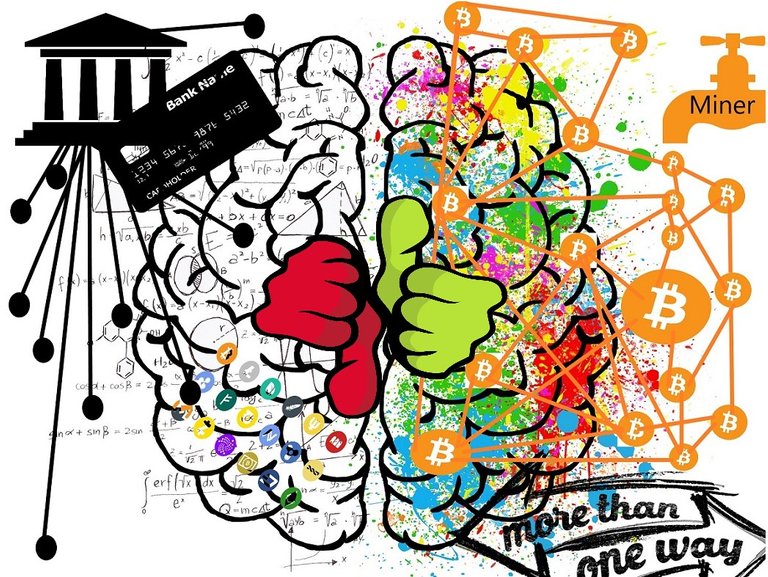
I have written a philosophical article on distributed structures in the past and have marked points why these structures represent a welcome future. [Click] You can read this article here. [Click]
Especially on Minds.com the reactions to this post were huge. I have noticed that there is a lot of ambiguity about this topic and many people want to set a simple and vivid example. So how do you break the bridge to illustrate these distributed systems and their advantages?
Some of the following may be too little founded and too much history. I can understand that. However, there are just as many people who are currently being overwhelmed by the scientific articles and would like more vivid examples. Hence this unconventional contribution.
My approach: Imagine Bitcoin as a central company
The Bitcoin, reason to revive the discussion about the structures of our systems. Centralized, decentralized, distributed – order and chaos? Bitcoin is the bearer of the blockchain, a technology that is supposed to be characterized by security and democracy. The direct application: digital payments with a digital currency.
In order to better understand this, we are now mentally transforming the Bitcoin into a more familiar structure. Take Bitcoin, which is an independent company – Bitcoin Central Ltd. – founded by an established bank.

How does Bitcoin Central Ltd. work?
Bitcoin Central Ltd. operates a database which carries out financial transactions between parties and keeps records of these transactions. Comparable to an online bank, which, however, only allows transactions via the company’s own digital currency. The company provides infrastructure, i.e. computer centre, server, connection, software, protocol and so on and offers these to the users. Bitcoin Central Ltd. decides how many Bitcoin it “creates” and releases into the market. The same applies to who receives this Bitcoin, since Bitcoin Central Ltd. first of all owns the Bitcoin. The data registry is only available in the company’s data centres, which are solely responsible for controlling and monitoring that registry.
Let’s now look at three possible scenarios, which will help you to understand them in the following.
Scenario 1: Black hat: Where there is money, there are thieves.
Bitcoin Central Ltd. employs highly decorated programmers and Fintech specialists. However, an unknown hacker group succeeded in overcoming the security mechanisms and gaining access to the data register. All backup devices were not enough to detect or even prevent the manipulation of the data register in time. Within a few seconds, the attackers gained control over 50% of the entire Bitcoin. Even though Bitcoin Central Ltd. put the network on hold temporarily, the hackers realised a large part of the loot in an opaque way. The damage caused amounts to several billion. Bitcoin Central Ltd. and its security measures have failed. It finally decides to close the business. Investors and users suffer a total loss.

Scenario 2: An update is needed – who decides?
The speed of the network is too slow to meet user demands. Bitcoin Central Ltd. decides to increase the speed of transactions with the help of an update. In order to be able to realize this improvement, the company develops an improved protocol with some programmers. At the same time, however, Bitcoin Central Ltd. decided to significantly increase the transaction fee, supposedly in order to recover the development costs. The user community was not initiated into this decision and is left behind in disbelief.
Scenario 3 – Hans has lost his account data
Hans is a customer of Bitcoin Central Ltd. One day he finds out that he has lost his account information for his Bitcoin account. He looks on the company’s website for the support area and finally finds a phone number. He calls and is asked to write an email to the support email in which he lists the email address used and proves his identity by means of a photograph. After successful verification of this data, Hans receives his new access data and can use his account again.
So the procedure and the scenarios at the fantasy company Bitcoin Central Ltd.
Now I would like to transfer the above into reality.

The actual Bitcoin and the blockchain technology
The Bitcoin blockchain, a data protocol, open source and without real owner. The owners of this protocol are the miners. The people who provide the infrastructure for the Bitcoin blockchain. There are thousands of them, they live all over the planet. The miners insert transaction data into the blockchain, a kind of digital cash book, and receive bitcoins for the provision of infrastructure, specifically computing power. The protocol of the Bitcoin clearly defines how many Bitcoin a Miner receives for what work and what period of time, as well as how many Bitcoin there are in total. The blockchain, the digital cash book, is not only available once, it does not exist in any computer centre. Each of the miners and all other users interacting with the Bitcoin blockchain have a copy of this digital cash book. Thus all parties monitor and control the network together by comparing their copies of the blockchain with each other. Information is thus democratically checked and, if necessary, filtered. This concept of information management is the decisive factor when it comes to distributed systems.
In this case, the owners of the Bitcoin are first and foremost the miners who receive the Bitcoin as remuneration for providing the infrastructure. They can sell their Bitcoin on the open market, so that others can also get their hands on it.
Now we also want to apply the above fictitious scenarios to this reality to illustrate the difference between centrality and distribution.
Scenario 1: Black hat: Where there is money, there are thieves.
An unknown group of hackers is trying to damage the blockchain network. Their goal is to gain possession of a large number of Bitcoin and convert them into USD. So far, the group has not been able to access the private keys of larger Bitcoin addresses. They were only able to obtain smaller sums thanks to the carelessness of some users. After many approaches did not lead to success, the attackers decided to smuggle a manipulated copy of the blockchain into the network. However, the network could democratically validate that the corresponding information was invalid. So this attempt was also unsuccessful. In order to import their manipulated copy of the blockchain, the group has to deceive 51% of the network. This means it would have to occupy around 600,000 computers at present. A challenge that the attackers (so far) are not up to

Scenario 2: An update is needed – who decides?
The speed of the network is too slow to meet user demands. Various miners and users of the Bitcoin Blockchain advise on how to solve this problem. Since the network is democratically structured, agreement must be reached between the various parties. Only if the majority, in the best case all, pull along, the implementation of a change succeeds. In this case, the network has decided to introduce a new protocol, which changes the transaction mechanism. Thanks to improved technology, transactions can not only be carried out faster, but also more cost-effectively.
This decision was democratically enforced after weeks of discussion with various stakeholders. The network made the decision intrinsically.
Some miners – significantly fewer than the majority – have spoken out against the update. They continue to operate the previous model and have “officially” cloned the blockchain. In this case one speaks of a Hard-Fork.
Scenario 3 – Hans lost his account data
Hans has a Bitcoin address with credit. In order to be able to access this credit, he generated or had generated a private key some time ago. So that Hans Bitcoin credit is protected, the secret key consists of a 32 character long code, which cannot be cracked manually. Although Hans is convinced that no one can guess this code, he cannot even remember it very well. That’s why Hans wrote down the private key, supposedly secure. Recently Hans moved and didn’t think about his Bitcoin at all in all the stress. Now that the hustle and bustle has subsided, Hans wants to see what’s going on. The evil awakening is approaching, he can’t find his note with the private key again. Even hours of searching don’t reveal the white note anymore and Hans can’t access his Bitcoin credit. He inquires on the Internet, but does not find a central contact point.
After a while, Hans understands that his Bitcoin is lost until he finds the note or remembers the code. His research shows that, due to the distributed system, no central authority is capable of resetting his secret key or reading it out.
Hans remains frustrated and will handle sensitive data much more carefully in the future.
A side note referring to scenario 3:
I believe that decentralised systems can be a real enrichment for us humans in some areas. These systems empower us in our freedom of choice and promise independence. But as power increases, so does the demand for responsibility. Fire is not dangerous, provided you know how to deal with it.
A conclusion for comparison
The first example illustrates central systems. The second example is an image of decentralized systems. The introductory question dealt with making decisions. In the first example, we saw that a central authority can make decisions without being disturbed by the user community. In contrast to this, the second example shows the intrinsic decision of the network, which was made from the point of view of the miners and the user community. This decision is thus directly related to the needs and demands of the users.
The decision on the accuracy of data was also explained. In example 1 it was enough to deceive a central instance and manipulate the data in this way. In distributed systems – example 2 – the evaluation of the data takes place democratically, manipulation is considerably more difficult because too many independent nodes are involved.
Of course one could still write about false intentions of central instances. About the fact that black-hat activities of individual nodes can be effectively counteracted in distributed systems. However, I would like to conclude my conclusion with a final remark about the above marginal note:
I am convinced that distributed systems can be a real enrichment for people in some areas. In some areas distributed systems will have absolutely no future, in others distributed systems will empower individual network participants. But as power increases, the demands on one’s own sense of responsibility will also increase. Not only in terms of dealing with sensitive data, but also in terms of making decisions.
With this in mind, I will conclude this article.
Got it... Thanks ,good system
This post has received a 23.21 % upvote from @boomerang.
You got a 24.69% upvote from @upmewhale courtesy of @besteulz!
Earn 100% earning payout by delegating SP to @upmewhale. Visit http://www.upmewhale.com for details!